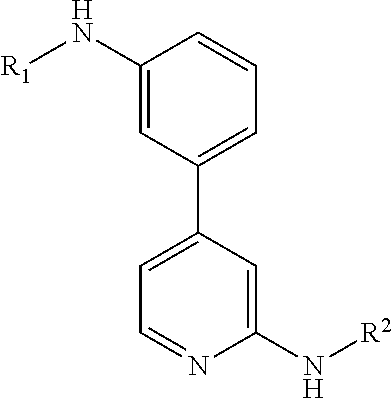Inhibitors of protein kinases
a technology of protein kinase and inhibitor, which is applied in the direction of biocide, drug composition, immunological disorders, etc., can solve the problems of limited kinase selectivity of presently known inhibitors, debilitating or dangerous side effects, and insufficient physiological functions of these inhibitors, and achieve the effect of optimizing the therapeutic
- Summary
- Abstract
- Description
- Claims
- Application Information
AI Technical Summary
Benefits of technology
Problems solved by technology
Method used
Image
Examples
example 1
N-(4-(4-Fluoro-2-methoxyphenyl)pyridin-2-yl)cyclohexanecarboxamide
[0307]Preparation of the Starting Material Cyclohexanecarboxamide. Aqueous Ammonia was Added to solution of cyclohexanecarbonyl chloride (500 mg, 3.41 mmol) in CHCl3 (10 ml). After completion of reaction, the reaction mixture was diluted with CHCl3 (2×30 ml). The organic layer was washed with saturated sodium bicarbonate solution, brine and dried over anhydrous sodium sulfate. The organic layer was concentrated under vacuum, crude compound was washed with hexane (2×8 ml) and dried to afford 200 mg (46.1%) of cyclohexanecarboxamide.
[0308]Preparation of Example 1. Example 1 was synthesized according to Method B starting from the above described cyclohexanecarboxamide (75.0 mg, 0.53 mmol), Cs2CO3 (262 mg, 0.79 mmol), 2-chloro-4-(4-fluoro-2-methoxyphenyl)pyridine (100 mg, 0.42 mmol), xantphos (25 mg, 80 μmol) and Tetrakis(triphenylphosphine)palladium (0) (24 mg, 40 μmol) in 1,4-dioxane (5 ml) at 120-125° C. for 3 h in a s...
example 2
2-Cyclohexyl-N-(4-(4-fluoro-2-methoxyphenyl)pyridin-2-yl)acetamide
[0309]Preparation of the starting material 2-Cyclohexylacetamide. Aqueous ammonia was added to solution of 2-cyclohexylacetyl chloride (500 mg, 3.11 mmol) in CHCl3 (10 ml). After completion of reaction, the reaction mixture was diluted with CHCl3 (2×30 ml). The organic layer was washed with saturated sodium bicarbonate solution, brine and dried over anhydrous sodium sulfate. The organic layer was concentrated under vacuum, crude compound was washed with hexane (2×8 ml) and dried to afford 400 mg (87.8%) of 2-cyclohexylacetamide.
[0310]Preparation of Example 2. Example 2 was synthesized according to Method B starting from the above described 2-cyclohexylacetamide (75.0 mg, 0.59 mmol), Cs2CO3 (262 mg, 0.79 mmol), 2-chloro-4-(4-fluoro-2-methoxyphenyl)pyridine (111 mg, 0.47 mmol), xantphos (27 mg, 47 μmol) and Tetrakis(triphenylphosphine)palladium (0) (27 mg, 23 mop in 1,4-dioxane (5 ml), and was purified after usual worku...
example 3
N-(4-(4-Fluoro-2-methoxyphenyl)pyridin-2-yl)piperidine-4-carboxamide
[0311]Step A: Preparation of tert-butyl 4-Carbamoylpiperidine-1-carboxylate. To a solution of isonipecotamide (500 mg, 3.90 mmol) in a mixture of 5% aqueous sodium carbonate (7 ml) and 1,4-dioxane (3 ml) was added Boc-anhydride (1.30 ml, 5.85 mmol) and stirred for 5 h at room temperature. The pH was adjusted to 5-6 with acetic acid and volatiles were evaporated under vacuo. The residue was triturated with n-pentane and diethyl ether to yield 740 mg (82.4%) of tert-butyl 4-carbamoylpiperidine-1-carboxylate as a white solid.
[0312]Step B: The Boc-protected precursor of Example 3 tert-butyl 4-(4-(4-fluoro-2-methoxyphenyl)pyridin-2-ylcarbamoyl)piperidine-1-carboxylate was synthesized according to Method B starting from the above obtained compound tert-butyl 4-carbamoylpiperidine-1-carboxylate (100 mg, 0.44 mmol), 2-chloro-4-(4-fluoro-2-methoxy-phenyl)pyridine (94 mg, 0.4 mmol), Cs2CO3 (184 mg, 0.56 mmol), xantphos (13 mg...
PUM
| Property | Measurement | Unit |
|---|---|---|
| Volume | aaaaa | aaaaa |
| Volume | aaaaa | aaaaa |
| Molar density | aaaaa | aaaaa |
Abstract
Description
Claims
Application Information
 Login to View More
Login to View More - R&D
- Intellectual Property
- Life Sciences
- Materials
- Tech Scout
- Unparalleled Data Quality
- Higher Quality Content
- 60% Fewer Hallucinations
Browse by: Latest US Patents, China's latest patents, Technical Efficacy Thesaurus, Application Domain, Technology Topic, Popular Technical Reports.
© 2025 PatSnap. All rights reserved.Legal|Privacy policy|Modern Slavery Act Transparency Statement|Sitemap|About US| Contact US: help@patsnap.com



